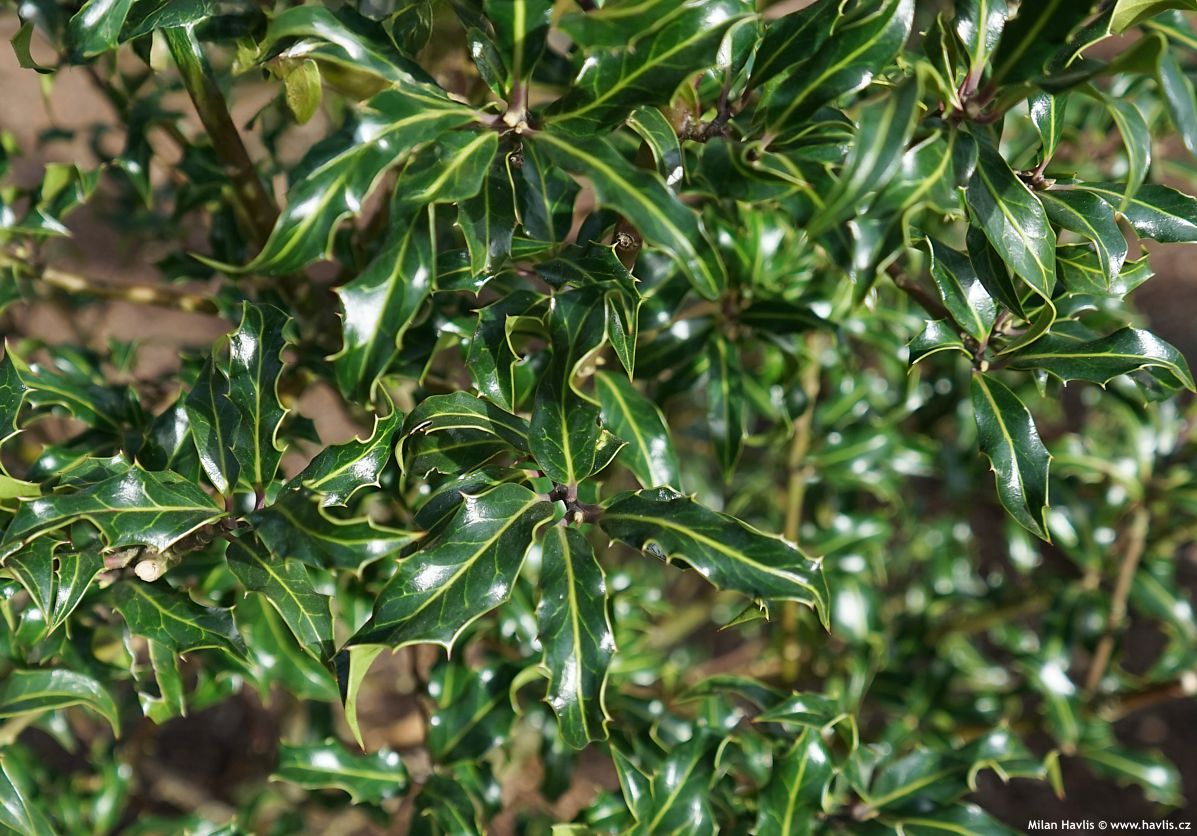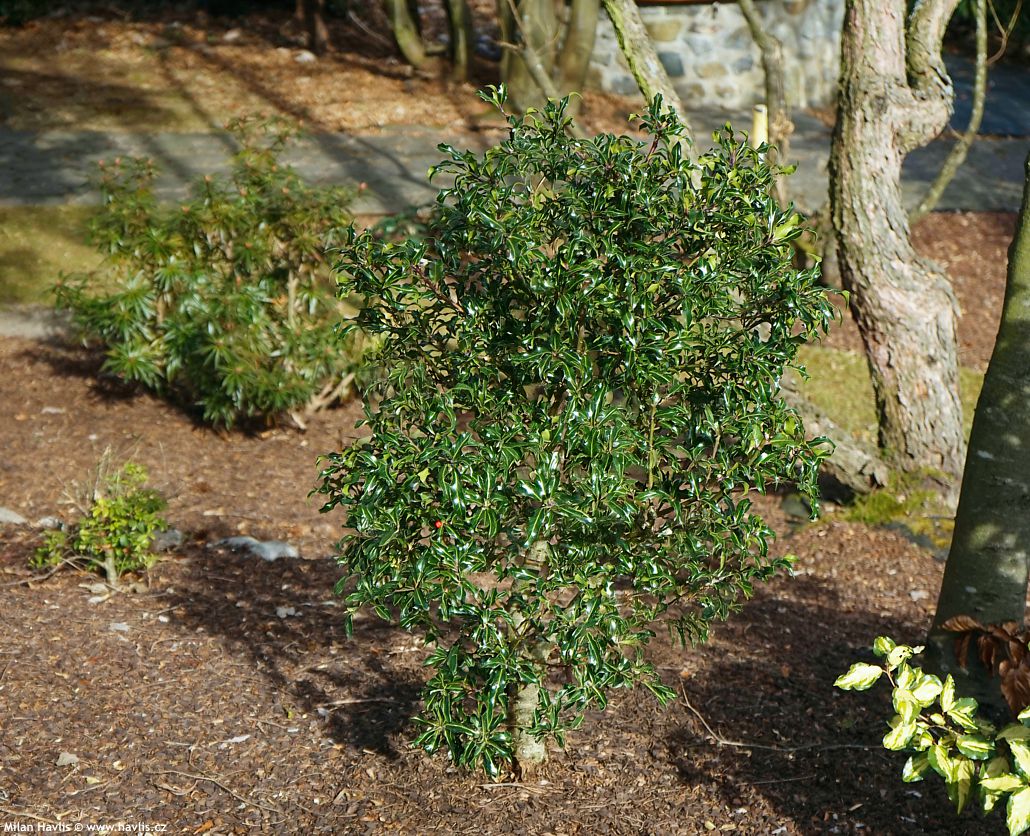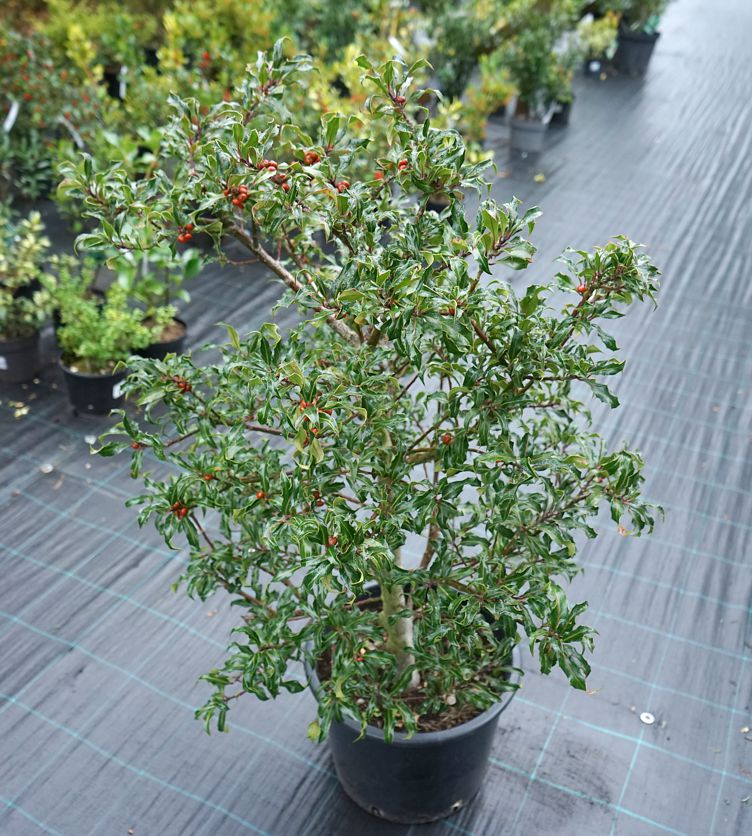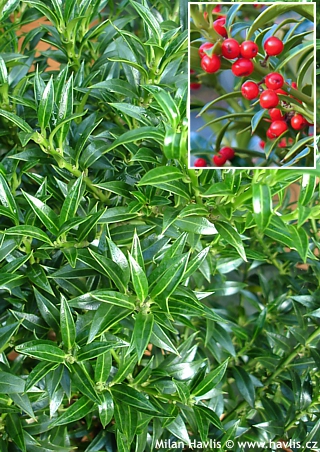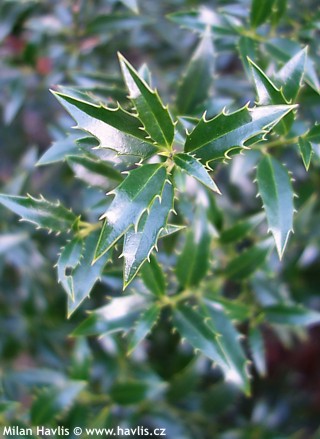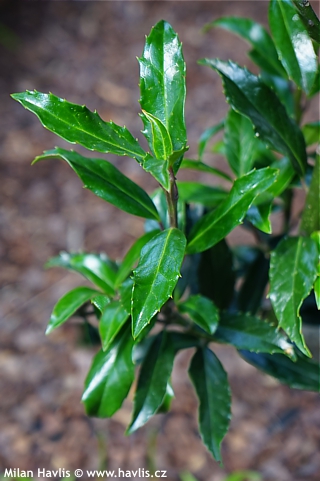Ilex aquifolium 'LICHTENTHALII' European holly
Ilex
The genus Ilex comprises between 400 and 600 species (depending on how one counts them, e.g. at Kew they list slightly over 570) and is today considered the largest genus of dioecious woody plants in the world. It is very ancient – fossilized leaves and pollen attest to its existence as far back as the Cretaceous period, and the earliest cultural records confirm that the ancient Romans used holly during the Saturnalia festivities as a symbol of fertility and protection. The genus was first described by Carl Linnaeus in 1753 in his Species Plantarum. Yet, I would give even greater credit and thanks to another botanist. More than a century later, Ludwig Eduard Loesener from Germany took on the titanic task of working through a genus with more than four hundred species spread across the globe. His monumental Monographia Aquifoliacearum (1901–1908, supplemented in 1942) became the foundational reference work to which scholars still turn today. In its pages one finds not only valuable and detailed facts about individual species and their differences, but also a palpable sense of Loesener’s passion for the sheer variety with which hollies can so easily overwhelm you.
The European holly (Ilex aquifolium) is one of the most common evergreen woody species of European origin, and at the same time the only native European representative of the genus. Its natural range covers western, southern, and central Europe, extending into North Africa (Morocco, Algeria, Tunisia) and western Asia (the Caucasus, Turkey, Syria). It is most abundant in areas with an oceanic climate – the British Isles, northern France, the Benelux countries, and the warmer parts of Germany – where it forms part of natural woodland, often beneath oaks and beeches. To the north it reaches as far as Norway, to the south the Mediterranean, and to the east the Balkans and the Caucasus. In Central Europe, holly does not occur naturally, though self‑sown seedlings sometimes appear near gardens where birds have carried the seeds. Thanks to its glossy foliage, often variegated, it has become a popular ornamental shrub, while the spiny forms have traditionally been used as natural barriers as natural barriers to wildlife and in hedging.
Lichtenthalii is a cultivar of European holly whose origins remain shrouded in mystery. You may come across it here and there in collectors’ gardens, occasionally in arboreta devoted to evergreen trees, but no one can tell you where it truly came from. Its name points to Lichtenthal near Baden‑Baden in Germany, yet nothing more is known. Perhaps, behind the walls of the local Cistercian monastery founded in the 13th century, secret botanical experiments once took place, however, their records were locked away in a private library. All we know is that it is no teenager, for at Wakehurst Place in Sussex, England, there already stands a large, venerable specimen. Or did this holly arise as a chance mutation in a monastic garden, from which some curious botanist once snatched a twig and began propagating it without the monks’ knowledge? Later, gnawed by conscience, did he at least name it after the monastery? Or perhaps… well, let us leave that veil of mystery unlifted. It is precisely this aura of secrecy that lends the plant its special charm – like the enigma of the Mona Lisa.
The holly ‘Lichtenthalii’ is rightly considered a collector’s gem, for it is fascinating and unlike any other. It bears evergreen, narrowly elongated leaves, typically slightly twisted, wavy, or curled, giving a more delicate impression than those of common hollies. They are leathery, very glossy, and firm to the touch. The margins are irregularly spiny in youth, becoming almost entire – perfectly smooth – with age. Their dark green surface contrasts with a lighter midrib that accentuates their shape. In spring, small white flowers appear, attracting pollinating insects. As a female cultivar, it may, in the presence of a male plant, produce red berries that ripen in autumn and persist into winter, though fruiting is not always regular. The berries are inedible to mildly toxic for humans, but a welcome winter feast for birds.
Overall, this is a slow‑growing, evergreen shrub or small tree with a dense, spreading to rounded habit. It is sometimes nicknamed the “hedgehog holly” depicting its unusual shape. At maturity it usually reaches about two to three meters in height and width. With its subtle foliage and compact growth, it makes a rare and striking specimen, especially suited to smaller gardens and collections. Any pruning is best carried out in early spring before new growth begins, but after the hardest frosts have passed.
Hollies should be grown in full sun or partial shade; they will tolerate shade but lose their form there. They require acidic to neutral, light and well‑drained, nutrient‑rich soil (especially fruiting cultivars), which remains moist but never waterlogged – they dislike prolonged drought. Clay in the upper soil layers is usually unsuitable, so it is better to plant make a raised bed for them in such case and backfill with a mixture of native soil and quality acidic substrate. By contrast, clay in deeper layers, once the roots reach it, is beneficial. In poorer soils, feeding is important, and the use of mycorrhizal fungi at planting is even more crucial. Before and during winter, whenever the ground is not frozen, watering is recommended. ‘Lichtenthalii’ is hardy to at least –24 °C and can withstand short spells a few degrees lower (USDA zone 6).
Last update 03-10-2025
Goods are shipped all over Europe. For Russia and U.K. and for further details please read about SHIPPING OPTIONS HERE.
Are you interested in a serious discount for orders NOV-FEB? Check your options here.
THE PRICES INCLUDE VAT of 15%. For quick conversion you can use 1 CZK = approx. 0.04 EUR
- STANDARD QUALITY - Plants of this group are 1st class quality with number of branches and overall density adequate to their size and age, considering they were container grown.
- DE LUXE QUALITY - This label guarantees a luxurious quality of manually selected plants that, compared to their height and age, are exceptionally dense and beautiful.
- EXTRA - These plants are usually mature and bigger specimens with exceptional overall appearance.
- STANDARD (as described in the plant form) means a tree with a trunk of 190-210 cm and a crown at the top, unless specified differently. The commercial size for trees is their girth measured in the height of 1m from ground.
- HOBBY - These plants are of the same quality as our standard-quality plants but younger and therefore cheaper.
- SHRUB - a woody plant with branches growing bushy from the ground level.
- HALF-STANDARD or MINI-STANDARD - a small tree with shorter trunk, its size is usually specified.
- FEATHERED - These are trees with branches growing already from the base of the trunk and up along the stem.
- GRASSES and PERENNIALS - Sizes given usually read the diameter of the pot or the clump, as specified.

































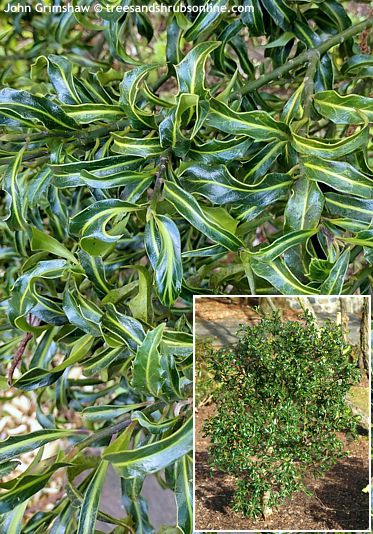
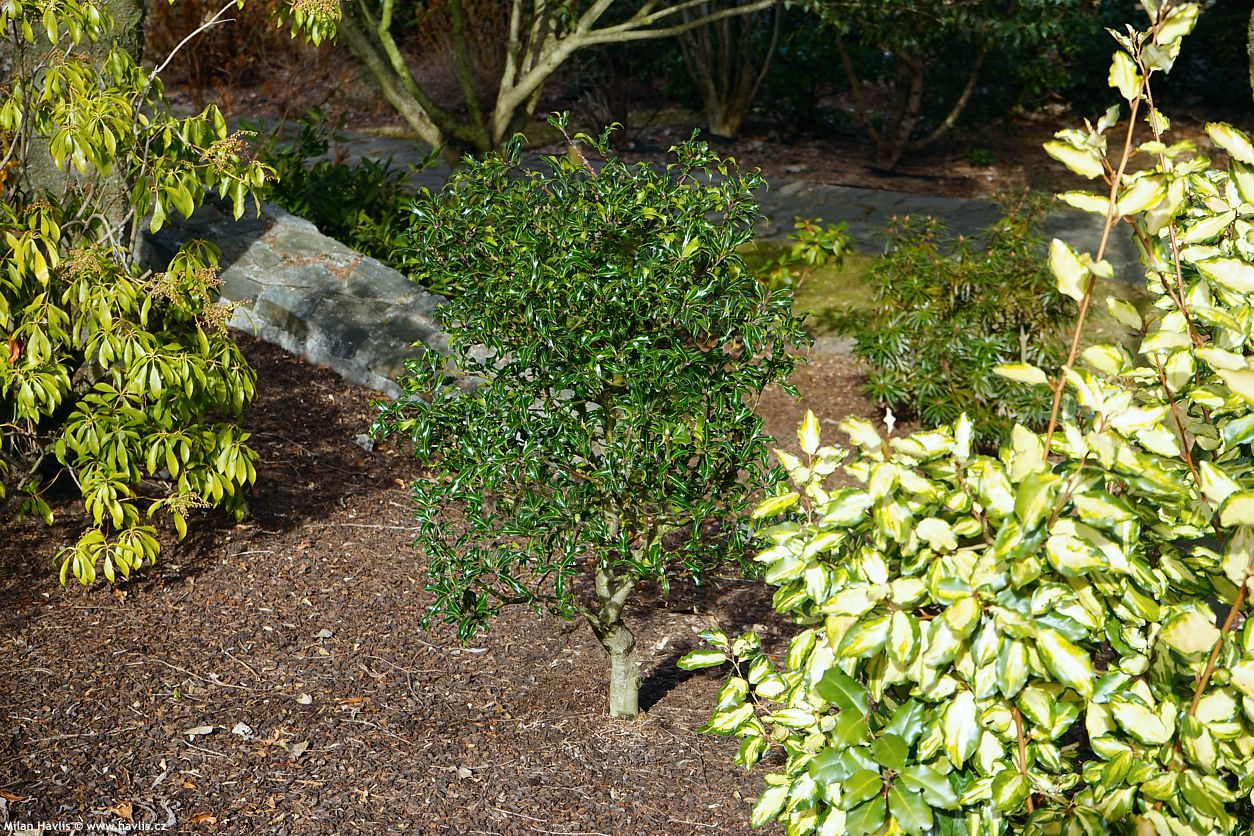
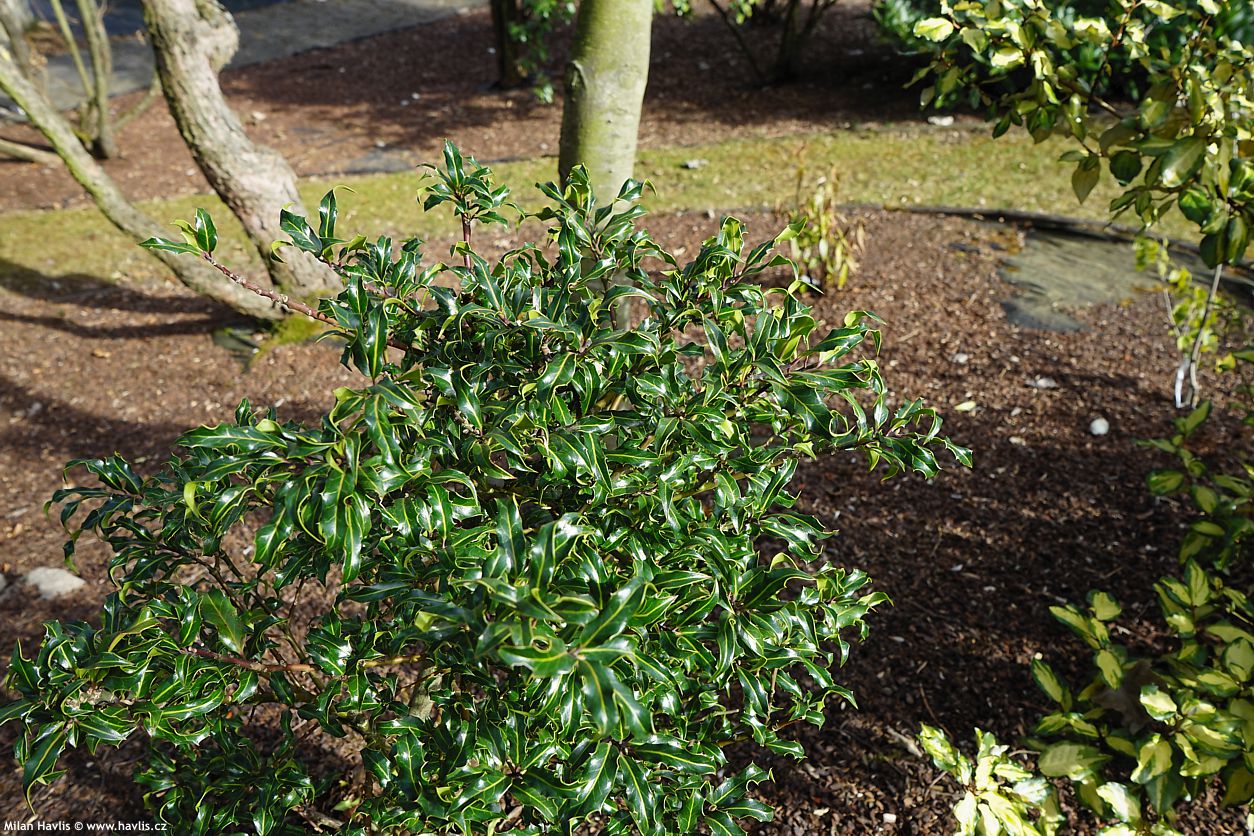
.jpg)
